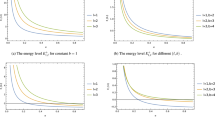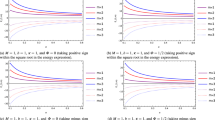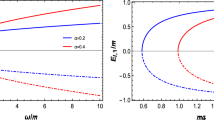Abstract
In this study, we explore quantum dynamics of non-relativistic particles within the context of a Morris–Thorne-type wormhole space-time featuring a cosmic string. Our investigation focuses on the eigenvalue solution of Schrödinger equation by utilizing the confluent Heun equation. We demonstrate that the cosmic string and the wormhole throat radius leads to significant modifications in the energy levels and wave functions of non-relativistic quantum particles. As a consequence, the degeneracy of the energy spectrum is disrupted. Subsequently, we extend our analysis to the harmonic oscillator problem, where non-relativistic particles interact harmonically within the same wormhole space-time background with a cosmic string. Employing a similar approach, we obtain the eigenvalue solution for the harmonic oscillator and analyze this solution to show the influence of the cosmic string parameter and the radius of the wormhole throat. In both scenarios, we obtain exact analytical solutions for the wave equation and specifically, we present the ground-state energy level \(E_{1,m}\) and the corresponding wave function \(\psi _{1,m}\) as particular cases.







Similar content being viewed by others
Data availibility
No new data were analysed in this study.
References
A Vilenkin Phys. Lett. B 133 177 (1983)
A Vilenkin Phys. Rep. 121 263 (1985)
B Linet Gen. Relativ. Gravit. 17 1109 (1985)
A Vilenkin and E P S Shellard Strings and Other Topological Defects (Cambridge: Cambridge University Press) (1994)
H Kleinert Gauge fields in Condensed Matter (Singapore: World Scientific) (1989)
M O Katanaev and I V Volovich Ann. Phys. (NY) 216 1 (1992)
K C Valanis and V P Panoskaltsis Acta Mech. 175 77 (2005)
R A Puntigam and H H Soleng Class. Quantum Grav. 14 1129 (1997)
K Bakke and C Furtado Phys. Rev. A 87 012130 (2013)
A V D M Maia and K Bakke Phys. B 531 213 (2018)
A V D M Maia and K Bakke Universe 168 3 8 (2022)
A V D M Maia and K Bakke Eur. Phys. J. C 79 551 (2019)
A V D M Maia and K Bakke Commun. Theor. Phys. 73 025103 (2021)
T Figielski J. Phys.: Cond. Matter 14 12665 (2012)
W C F da Silva and K Bakke Ann. Phys. (NY) 421 168277 (2020)
R L L Vitoria and K Bakke Eur. Phys. J. C 78 175 (2018)
S Zare, H Hassanabadi and G Junker Eur. Phys. J. Plus 138 354 (2023)
H Hassanabadi, S Zare, J Kříž and B C Lütfüoğlu EPL 132 60005 (2020)
S Zare, H Hassanabadi and M de Montigny Eur. Phys. J. Plus 135 122 (2020)
B C Lütfüoğlu, J Kříž, S Zare and H Hassanabadi Phys. Scr. 96 015005 (2021)
B C Lütfüoğlu, J Kříž, P Sedaghatnia and H Hassanabadi Eur. Phys. J. Plus 135 691 (2020)
P Sedaghatnia, H Hassanabadi and G J Rampho Int. J Mod. Phys. A 35 2050108 (2020)
S Zare, H Hassanabadi, G J Ra, G J Rampho and A N Ikot Eur. Phys. J. Plus 135 748 (2020)
S Zare, H Hassanabadi and Marc de Montigny Int. J Mod. Phys. A 35 2050195 (2020)
S Hassanabadi, S Zare, B C Lütfüoğlu, J Kříž and H Hassanabadi Int. J Mod. Phys. A 36 2150100 (2021)
A Guvendi, S Zare and H Hassanabadi Eur. Phys. J. A 57 192 (2021)
S Zare, H Hassanabadi and G Junker Int. J. Mod. Phys. A 36 2150215 (2021)
S Zare, H Hassanabadi and A Guvendi Eur. Phys. J. Plus 137 589 (2022)
S Zare, H Hassanabadi and G Junker Gen. Relativ. Gravit. 54 69 (2022)
M Hosseinpour, F M Andrade, E O Silva and H Hassanabadi Eur. Phys. J. C 77 270 (2017)
M Hosseinpour and H Hassanabadi Int. J. Mod. Phys. A 30 1550124 (2015)
W C F da Silva, K Bakke and R L L Vitoria Eur. Phys. J. C 79 657 (2019)
M J Bueno, C Furtado and K Bakke Physica B: Cond. Matter 496 45 (2016)
C Furtado and F Moraes J. Phys. A: Math. Gen. 33 5513 (2000)
F. Ahmed Proc. R. Soc. A 479 20220624 (2023)
S Azevedo Phys. Lett. A 288 33 (2001)
R. L. L. Vitoria and H. Belich Phys. Scr. 94 125301 (2019)
L. C. N. Santos, F. M. Da Silva, C. E. Mota and V. B. Bezerra Int. J. Geom. Meth. Mod. Phys. 20 23F.M.50067 (2023)
F Ahmed EPL 141 54001 (2023)
F Ahmed Sci. Rep. 13 12953 (2023)
K Bakke Eur. Phys. J. Plus 134 546 (2019)
W. C. F. da Silva and K. Bakke Class. Quantum Grav. 36 235002 (2019)
L. F. C. Pereira, F. M. Andrade, C. Filgueiras and E. O. Silva Few-Body System 63 64 (2022)
C Filgueiras and F Moraes Ann. Phys. (NY) 323 3150 (2008)
C. Filgueiras, E. O. Silva and F. M. Andrade J. Math. Phys. 53 122106 (2012)
C Furtado, B G C da Cunha, F Moraes, E R Bezerra de Mello and V B Bezzerra Phys. Lett. A 195 90 (1994)
G Ferrari and G Cuoghi Phys. Rev. Lett. 230403 230403100 (2008)
E. O. Silva, S. C. Ulhoa, F. M. Andrade, C. Filgueiras and R. G. G. Amorin Ann. Phys. (NY) 362 739 (2015)
K. Bakke and C. Furtado Int. J Geom. Meths. Mod. Phys. 16 1950172 (2019)
L. Dantas, C. Furtado and A. L. S. Netto Phys. Lett. A 379 11 (2015)
C Furtado EPL 79 57001 (2007)
A L S Netto, C Chesman and C Furtado Phys. Lett. A 372 3894 (2008)
C O Edeta and A N Ikot Rev. Mex. Fis. 68 051501 (2022)
C Furtado and F Moraes EPL 45 279 (1999)
H Chen, S Zare, H Hassanabadi and Z-W Long Indian-J Phys. 96 4219 (2022)
H Hassanabadi and M Hosseinpour Eur. Phys. J. C 76 553 (2016)
S. Zare, H. Hassanabadi and Marc de Montigny Int. J Mod. Phys. A 35 2050071 (2020)
G D A Marques, J G De Assis and V B Bezerra J. Math. Phys. 48 112501 (2007)
G D A Marques and V B Bezerra Class. Quantum Grav. 19 985 (2002)
L Flamm Physikalische Zeitschrift XVII 448 (1916)
A Einstein and N Rosen Phys. Rev. 48 73 (1935)
H G Ellis J. Math. Phys. 14 104 (1973)
K A Bronnikov Acta Phys. Pol. B 4 251 (1973)
J A Gonzalez, F S Guzman and O Sarbach Class. Quantum Grav. 26 01510 (2009)
J A Gonzalez, F S Guzman and O Sarbach Class. Quantum Grav. 26 015011 (2009)
J L B Salcedo, X Y Chew and J Kunz Phys. Rev. D 98 044035 (2018)
J L B Salcedo, M A Dariescu, C Dariescu, E Radu and C Stelea Phys. Lett. B 827 136993 (2022)
M S Morris and K S Thorne Amer. J. Phys. 56 395 (1988)
M Visser Lorentzian wormholes: From Einstein to Hawking (USA: Woodbury) (1995)
T Müller Phys. Rev. D 77 044043 (2008)
S Eyasmin, D Chakraborty and M Sarkar J. Geom. Phys. 174 104457 (2022)
F R Klinkhamer Acta Phys. Polo. B 54 5-A3 (2023)
F Ahmed EPL 142 39002 (2023)
A Ahmed Few-Body System 64 80 (2023)
A Ronveaux Heun’s Differential Equations (Oxford: Oxford University Press) (1995)
M Abramowitz and I A Stegun Handbook of Mathematical Functions with Formulas, Graphs, and Mathematical Tables (New York: Dover) (1972)
G B Arfken and H J Weber Mathematical Methods for Physicists (New York: Elsevier Academic Press)) (2005)
Author information
Authors and Affiliations
Corresponding author
Ethics declarations
Conflict of interest
There are no conflict of interests regarding the publication of this paper.
Additional information
Publisher's Note
Springer Nature remains neutral with regard to jurisdictional claims in published maps and institutional affiliations.
Appendices
Appendix 1: The solutions of angular equations
Substituting (7) in the Eq. (8) and using the wave function (9), one will find the angular equation (12) as follows:
Let us substitute \(Y (\theta ,\phi )=A(\theta )\,B(\phi )\) in the Eq. (43) and after simplification, we obtain the azimuthal equation as follows:
And the polar equation
Let a solution to the Eq. (44) is given by
Substituting (46) in the Eq. (44), we obtain
For the Eq. (45), let us change a variable by \(x=\cos \theta \). The equation with the function \(A(\theta )\) becomes
which is the associated Legendre polynomials equation whose solutions are given by
where superscript \(m'\) indicates the order and \(P_{\ell '} (x)\) are polynomials of degree \(\ell '\) given by
Noted that the Legendre polynomials \(P_{\ell '} (x)\) are polynomials of order \(\ell '\) provided the magnetic quantum number \(m'\) must have values less than or equal to \(\ell '\). That is
Throughout the analysis we have written \(\ell '\) and \(m'\) because of the presence of cosmic string in the quantum system. For \(\alpha \rightarrow 1\), one will get back the standard azimuthal and polar equations which were given in many textbooks. In that case, relation (51) can be written as \(\ell =(|m|+\kappa )\). Thus, one can see that the quantum numbers \((m',\ell ')\) are influenced by the topological defect of cosmic string, and these are called the effective magnetic and orbital quantum numbers, respectively.
Appendix 2: The confluent Heun equation
The standard form of the confluent Heun equation is [32, 75, 76]
where \(H(x)=H_{c}(\zeta , \beta , \gamma , \delta , \eta ;x)\) is the confluent Heun function. The parameters \(\mu \) and \(\nu \) given in the last term of Eq. (52) are defined as
By using the Frobenius method [77], one will obtain a polynomial solution to the confluent Heun equation. Let us write the confluent Heun function as a power series around the origin,
where \(d_i\) are the coefficients.
Thereby, substituting this power series in the Eq. (B.1), one will obtain the coefficient
with the following recurrence relation
Therefore, from the Eq. (B.5), the confluent Heun series becomes a polynomial of degree n when we impose two conditions:
where \(n=1,2,3,\ldots ..\) But, we don’t know whether a closed expression for the energy eigenvalue will exists or not.
Rights and permissions
Springer Nature or its licensor (e.g. a society or other partner) holds exclusive rights to this article under a publishing agreement with the author(s) or other rightsholder(s); author self-archiving of the accepted manuscript version of this article is solely governed by the terms of such publishing agreement and applicable law.
About this article
Cite this article
Ahmed, F. Morris–Thorne-type wormhole with a cosmic string effects on harmonic oscillator problem. Indian J Phys (2024). https://doi.org/10.1007/s12648-024-03118-2
Received:
Accepted:
Published:
DOI: https://doi.org/10.1007/s12648-024-03118-2




